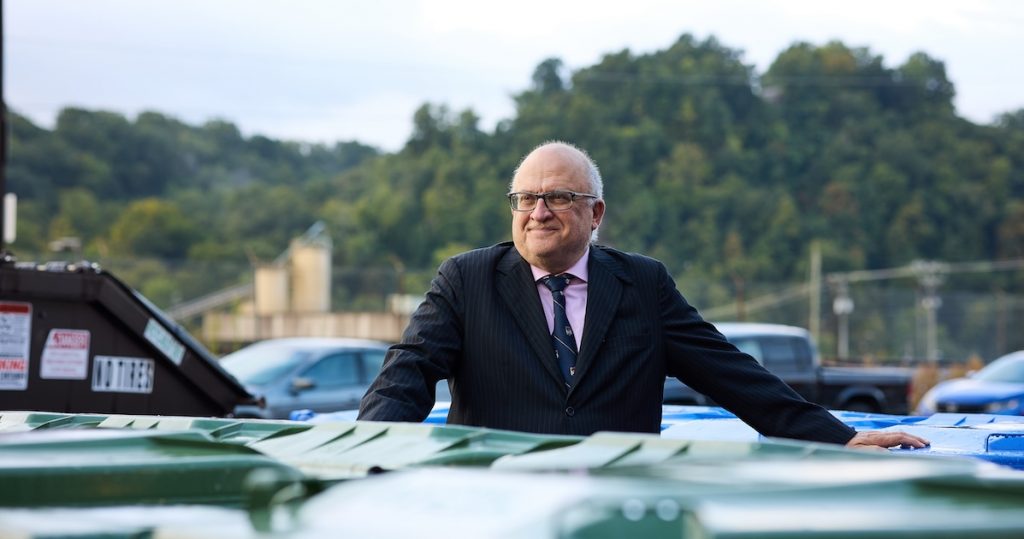What do damaged crops, acid rain, and urban haze have in common?
They are all problems that Art Ragauskas hopes to fix with wood.
Ragauskas, the UT-ORNL Governor’s Chair for Biorefining and interim head of UT’s Department of Chemical and Biomolecular Engineering (CBE), has spent more than a decade researching sustainable, biologically derived alternatives to industrially important substances like petroleum fuel.
Burnt Out on Bunker Fuel
One of the hardest fuels to replace has been bunker fuel, also known as heavy fuel oil (HFO), which is composed of the highest-molecular weight fuel compounds in petroleum. Those molecules do not have many applications, but they have found a home in the engines of heavy marine vessels like cargo ships. Unfortunately, burning HFO results in airborne sulfur—which causes breathing problems, stifles plant growth, contributes to acid rain, and reduces visibility in polluted air.
“It is globally acknowledged that transoceanic shipping will have to move away from petroleum resources,” Ragauskas said. “In addition to regulations throughout the globe restricting sulfur emissions from marine vehicle exhaust, there are longer-term concerns about greenhouse gas emissions from petroleum combustion.”
Unfortunately, as a low-performance and low-demand fuel, HFO has both an unusually high viscosity and an unusually low cost. That makes transitioning to clean energy sources a bigger struggle for marine shipping than for some other industries.
“Whatever you want to use for displacing bunker fuel, it has to have comparable chemical and physical properties so you can swap it in without causing new problems or asking shipping companies to replace their engines,” Ragauskas said. “And all of this has got to be done on a cost-competitive basis. You can’t replace sand with gold.”
The solution may be to replace one low-demand product with another.
Fuel From Wastewood
Up to 30% of wood from the average tree is made of lignin, an irregular class of molecules that hinders the creation of common biofuels like ethanol.
“Historically, lignin has had such low value that it’s often just burned to gain power,” Ragauskas said. “But a variety of people throughout the world, including my group, are actively pursuing research to utilize lignin for chemicals and fuels.”
One of Ragauskas’s colleagues, Associate Research Professor Charles Cai from the University of California, Riverside, has recently developed an efficient method to break wood down and separate its lignin into two chemically consistent streams.
Cai’s Co-Solvent Enhanced Lignocellulosic Fractionation (CELF) process extracts lignin from wood; the researchers can then separate the high-molecular weight lignin (HMWL) from the low-molecular weight lignin (LMWL). The former is promising for use in sustainable aviation, while LMWL seems destined for the sea.
“Charles has already shown that we can take a fraction of that CELF lignin, blend it with bunker fuel, and then get partially bio-based, partially petroleum-based HFO—and the bio-based fuel has no sulfur in it,” said Ragauskas. “You’re in essence diluting the petroleum component so that you can simultaneously address sulfur emissions and reduce the carbon footprint of the fuel.”
Ragauskas, Cai, and two other investigators—UC Riverside Associate Research Professor Arun Raju and Assistant Professor Chang Geun Yoo from the State University of New York College of Environmental Science and Forestry (ESF)—are now working to demonstrate CELF’s capacity for large-scale, continuous production of biofuels.
With $2.5 million in funding, including a grant from the Department of Energy’s Bioenergy Technologies Office, the UC Riverside team led by Cai and Raju is building a scaled-up pilot version of CELF that will process 1,000 pounds of sustainably harvested wood and wood waste per day. At ESF, Yoo will convert the resulting HMWL into sustainable aviation fuels.
Meanwhile at UT, Ragauskas and his PhD student Christian Kemefa will blend LMWL into HFO at varying proportions, then characterize the mixtures to ensure that they hold up to the marine fuel standards of ASTM International, the International Maritime Organization (IMO), and the International Organization for Standardization (ISO).
Combining Resources
While taking advantage of Ragauskas’s extensive background in biofuel characterization, he and Kemefa will also utilize the state-of-the-art chemical characterization equipment at Oak Ridge National Laboratory (ORNL).
“The unique thing about UT, and one of the reasons I came here as a Governor’s Chair, is the relationship between UT and ORNL,” Ragauskas said. “We are a student-focused research institution, and ORNL is more of a professional-focused research institution. We get this beautiful blend of both, forming partnerships with researchers at Oak Ridge while getting to make measurements that are really unique to the chemical problems we’re investigating.”
According to the team’s projections, replacing petroleum fuel with CELF HFO could reduce marine greenhouse gas emissions by up to 80% without increasing the cost of marine fuel or requiring any changes to existing engines or pipelines.
“Sometimes, even substantial improvements are not adopted because somebody has already invested a tremendous amount of money and time in creating vehicles or manufacturing and device pipelines,” Ragauskas said. “What’s so cool about this project is that we’re saying you can swap in a more sustainable fuel and get the same performance at approximately the same cost.”
Contact
Izzie Gall (865-974-7203, egall4@utk.edu)
